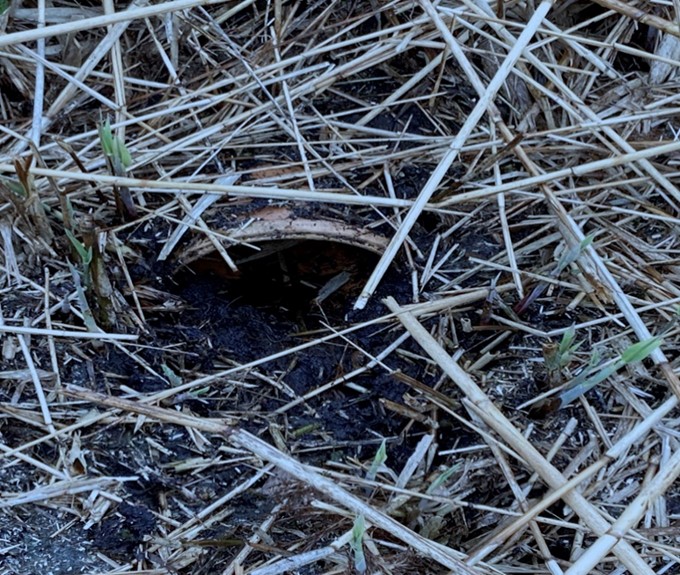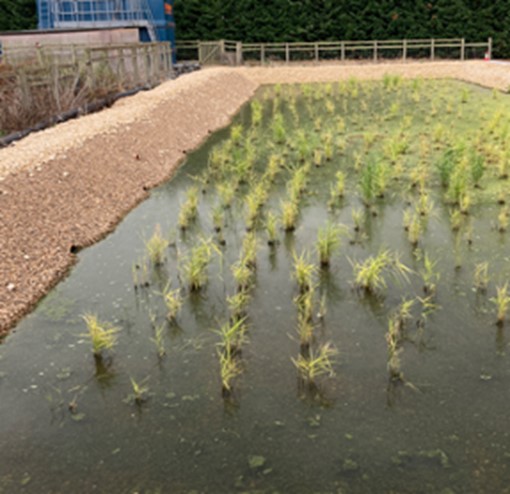A reed bed refurbishment as part of a site upgrade
Our client
Our client is a UK government ministerial department.
The location is a treatment works serving an operational site with living quarters. It’s been in existence for over a century and is historically significant.
The reed bed – measuring around 30m x 14m – forms part of a sewage treatment works.
Our situation
The site is undergoing a series of improvements, including an upgrade to the existing sewage treatment works where the reed bed is used in the final filtration process.
The treatment works will be condensed to free up more room to cater for additional facilities and to make way for the creation of rewilding spaces, that will complement the reed bed and promote biodiversity.

Site operatives were beginning to question the effectiveness of the reed bed. They suspected a problem with the liner and were concerned that effluent might be escaping.
We were asked to investigate the asset and make recommendations to help improve its effectiveness.
Our approach
As with every client, we explore all options and consider ways to avoid full refurbishments where possible.
After a full investigation, we created a site survey report which included our recommendations. This covered our assessment of the inlet pipework; the reed bed; the outlet pipework; and the grounds.
Our assessment showed that the inlet pipework was partially blocked with sludge and matted with reed material. In fact, 90% of the reed bed was weeds.
The reed bed itself had a damaged liner which was no longer fit for purpose, meaning sewage was seeping into woodland areas. On top of that, the reed bed contained heavy deposits of humus sludge which not only hinders the effectiveness of the asset but can also emit harmful greenhouse gases.
The outlet pipework was ageing, and more ports were required. The collection pipework they had was made from PVC and drilled with holes 3-5mm in diameter! But the grounds in general were in good condition, requiring minimal work.
Once our recommendations were signed off by our client, we went ahead and refurbished the reed bed in under two weeks. This involved removing or replacing the growing and stone media. In fact, three loads of reed bed sludge were excavated and removed from the site, and the remaining gravel and stone was recycled to be reused onsite.


We installed new pipework (double-walled slotted filter drainage pipework) and additional ports to facilitate improvements in the distribution of effluent along the reed bed.
Years of old ripped liners were replaced, and new reeds were planted with extra water valved in to feed the new reeds.
Before go-live, we created a recommissioning programme for our client to slowly reintroduce the humus effluent – at the correct flow rate – while the new reeds established themselves.
The reed bed has since been given an asset condition grade of ‘one’ (the highest grade you can get). It was previously rated ‘four’ (out of five).
Obstacles we overcame
Compromised structural integrity
We were concerned about the robustness of the concrete structure below the reed bed liner. But we were able to rule this out
Keeping operational
The site had to remain live while we did our work, but we helped our client to come up with a bypass solution
Local wildlife
While we were in the process of cleaning the pipework, a mother duck and her large family of ducklings decided to move in! We made sure they could exit safely and put in measures to stop more wildlife from entering the pipes, just in case they got stuck
Our impact
As a result of our work, we’ve:
- Provided our client with a refurbished reed bed that’s now playing its part in the sewage treatment process
- Prevented untreated sewage from escaping into nearby woodland areas causing environmental harm and regulatory violations. The reed bed now acts as the safety net before discharge into the environment
- Stopped the reed bed from potentially emitting harmful greenhouse gases
- Protected the reputation of our client
- Enhanced the natural beauty of the site
Final word from our client
“Oren Environmental completed the refurbishment of the reed bed at our site.
“It was completed in a very timely manner with the utmost professionalism and high standards of workmanship and safety.
“Oren Environmental has also returned to site to complete aftercare work to help us to manage the reeds and are currently installing a new safety fence and step access to the reed bed for our technicians to use when completing maintenance procedures.”
Client Engineer









